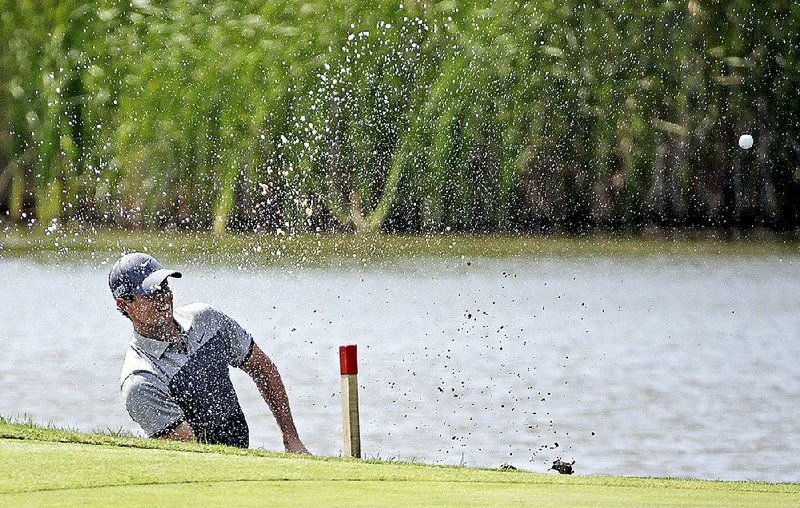Rory McIlroy's two main thoughts when he stepped into the lake at the side of the fifth green Thursday: Get the ball out of the water and don't get my feet wet.
Check and check.
The second part, staying dry, was especially important because his left ankle is still taped from the soccer injury he suffered this summer.
"If water gets through this shoe, then the tape gets wet, and then that would be a little more than just sort of annoying or uncomfortable for the rest of the day," he said.
McIlroy got up and down from the agua on No. 5 to save par -- the highlight shot in a round of 1-under 71.
He said he was nervous coming back for his first competitive round since the injury.
"As you can see out there, the way I'm hitting the ball and the way I'm getting around the golf course, I have full confidence in" the ankle, he said. "It doesn't bother me one bit."
Quote of the day
David Lingmerth (Arkansas Razorbacks) had a round of 5-under 67 -- shot in dry, windy conditions Thursday afternoon. Jordan Spieth said, "Whatever David ate this morning, I'd like to eat tomorrow, because that's a heck of a round of golf in those conditions."
Bunker mentality
Kerry Haigh, the PGA's chief championships officer, answered a question that has come up frequently this week: With more than 1,000 bunkers at Whistling Straits, and many that are seemingly out of play, why not declare that the bunkers inside the ropes are bunkers and the bunkers outside the ropes are not? Or why not declare only bunkers that have been raked as bunkers?
Haigh replied: "We have certain occasions where ropes go through half of a bunker, so half of it is raked; half of it will have people walking through it. And what would happen with a bunker outside the ropes but if somebody were to grab a rake and rake part of a bunker or part of the sand -- does that suddenly become a bunker?
"So obviously there would be so much confusion. We feel very comfortable with having all the bunkers here play as bunkers. They're built as bunkers, and they have sand in them."
Major test
Here's a way to test your marriage. Put your wife on the bag at a major championship.
For Steve Stricker, it was no big deal.
His wife, Nicki, is caddying for him at the PGA Championship. She's been on the bag before, and when Stricker's last caddie, Jimmy Johnson, recently went to work for tour rookie Justin Thomas, Stricker went back to his comfort zone.
"A guy may not want to say those things that a wife can say to you," Steve Stricker said.
But there were no harsh words Thursday. Stricker made a 24-foot putt on No. 18 to save par and finish at 1-under 71. A stress-free day, the Wisconsin player called it.
"I don't want to say it was an easy day, but we communicated well with one another and it was good talks back and forth," Stricker said.
Whether the weather
Brad Nelson is the most important person no one has heard of at this week's PGA Championship at Whistling Straits.
With one phone call, he can shut down one of the world's biggest golf tournaments and stop Jordan Spieth and Rory McIlroy in their tracks.
As the on-site meteorologist during the 97th PGA Championship, Nelson is closely monitoring weather conditions from lightning strikes and thunderstorms to dew points, temperatures and wind speed and direction. Course officials use his information about wind direction and intensity to determine where to set flagsticks on some greens and whether to move tee markers to shorten or lengthen holes.
"I like thunderstorms and severe weather, but not when I'm working at a major golf tournament," Nelson said.
Weather is critical during an outdoor event drawing tens of thousands of spectators as well as the world's best golfers, so Nelson has to be on his toes.
Using two Dell laptops and a big-screen TV, Nelson sits in a nondescript trailer on the grounds watching large-scale radar and satellite images as well as mesoanalysis of moisture in the atmosphere. When he arrived on Sunday, he climbed to the top of one of the many hills at Whistling Straits and set up a 60-pound, 8-foot-tall contraption that includes an anemometer for wind speed and direction and a lightning sensor he monitors wirelessly.
While rain can be annoying, it's lightning that's the most dangerous on golf courses.
"You don't think of who's out there, you think of everybody. You try to make the right decisions to keep everybody safe," said Nelson, who earned a meteorology degree at St. Cloud State in Minnesota.
Sports on 08/14/2015
